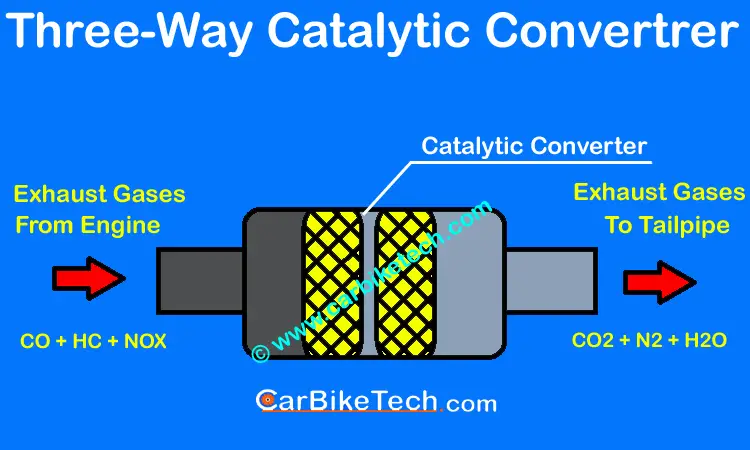What is a Catalytic Converter?
The catalytic converter or ‘Cat-Con’ is a mechanical device. It reduces the harmful emissions created in the exhaust system of an engine. It is an essential device as it works with the toxic gases the engine produces during fuel combustion. Its primary purpose is to reduce exhaust emissions.

The Cat-Con reduces the harmful exhaust gases through chemical reactions. It reacts with the harmful pollutants in the exhaust gases and turns them into lesser toxic gases. The catalytic converter consists of a special catalyst. Manufacturers make it of platinum and palladium, which carry out chemical reactions.
Construction of Catalytic Converter:
Its housing consists of a honeycomb core from the inside. Manufacturers coat it with precious metals such as platinum and rhodium. These metals react with the engine’s exhaust gases. As a result, they reduce the toxic contents of the gases and turn them into carbon dioxide and water.

At first, it reacts with the carbon monoxide generated by the combustion of gasoline. Then, it also reacts with the hydrocarbons formed by unburned fuel and other nitrogen oxide emissions. Thus, the cat-con converts these gases into less harmful by-products. They are the carbon-di-oxide, water vapor, and nitrous emissions.
Types of Catalytic Converters:
There are three different types of Cat-Cons. The first type is the oxidation catalyst. It reduces harmful pollutants such as carbon monoxide (CO) and fuel hydrocarbons (HC) in the exhaust. Simultaneously, it often uses a secondary air injection. However, the oxidation catalyst only reduces a portion of the pollutants.
Dual-bed:
The second type is the Dual-bed Catalytic-Converter which offers more perfection. It works in two stages. Two elements are situated one behind the other. The first stage helps in reducing the amount of nitrogen oxide emissions. The second stage reacts with the hydrocarbons created by unburned fuel and carbon mono oxide. The manufacturers also provide the secondary air injection in the two-stage type cat-con.
Three-Way Catalytic Converter:
The last type is the Three-Way Catalytic Converter. The Three-way catalyst helps convert the harmful gases exhausted from the engine into harmless gases. The engine exhaust gases contain hazardous substances that cause damage to the environment. These include the oxides of nitrogen, hydrocarbons, and carbon monoxide. The three-way catalyst converts them into less harmful carbon-di-oxide, water, and nitrogen.

The three-way cat-con is the only device that reduces all the three pollutants in one go. It functions most economically. Thus, most manufacturers employ a three-way type in their vehicles which need to meet stringent emission standards.
Working of the Three-Way Catalytic converter:
Furthermore, the three-way type uses two catalysts. One is a reduction catalyst, and another is an oxidation catalyst. The oxidation catalyst is made of palladium and platinum, whereas the reduction catalyst is of rhodium and platinum. However, both of them come with a ceramic honeycomb structure. Besides, manufacturers place it in a muffler-like compact unit that fits onto the exhaust pipe. Mainly, the automotive industry uses the Three-way Cat-con. It is because the vehicles have to pass many regulations for emission control.

Thus, the catalytic converter plays a vital role in reducing the amount of pollution created. It also reduces the harmful emissions and gases in the engine and the exhaust systems of all the cars across the globe.
Furthermore, for more information on cat-cons, please click here:
Watch The Three-way Cat-Con In Action Here:
Read More: What is MPFi/GDi in engines?>>
